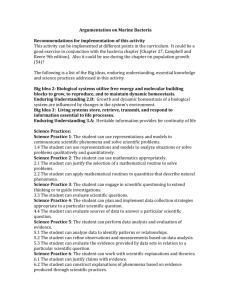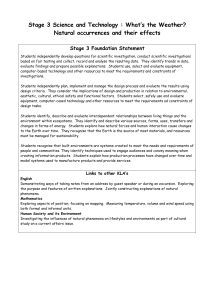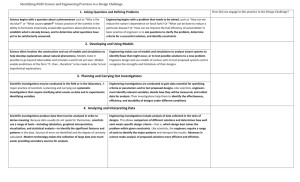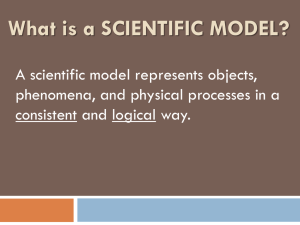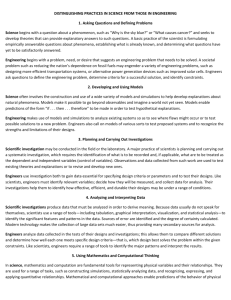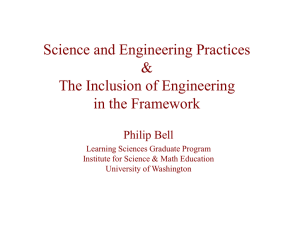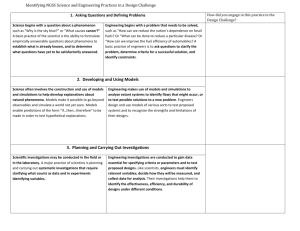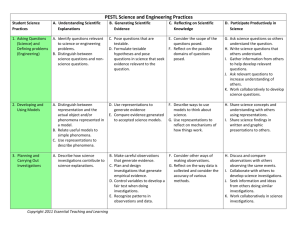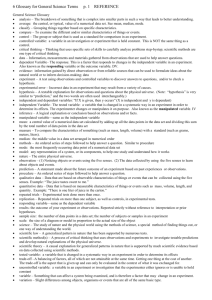Handout: Framework Practices excerpts (Pages 42-48)
advertisement
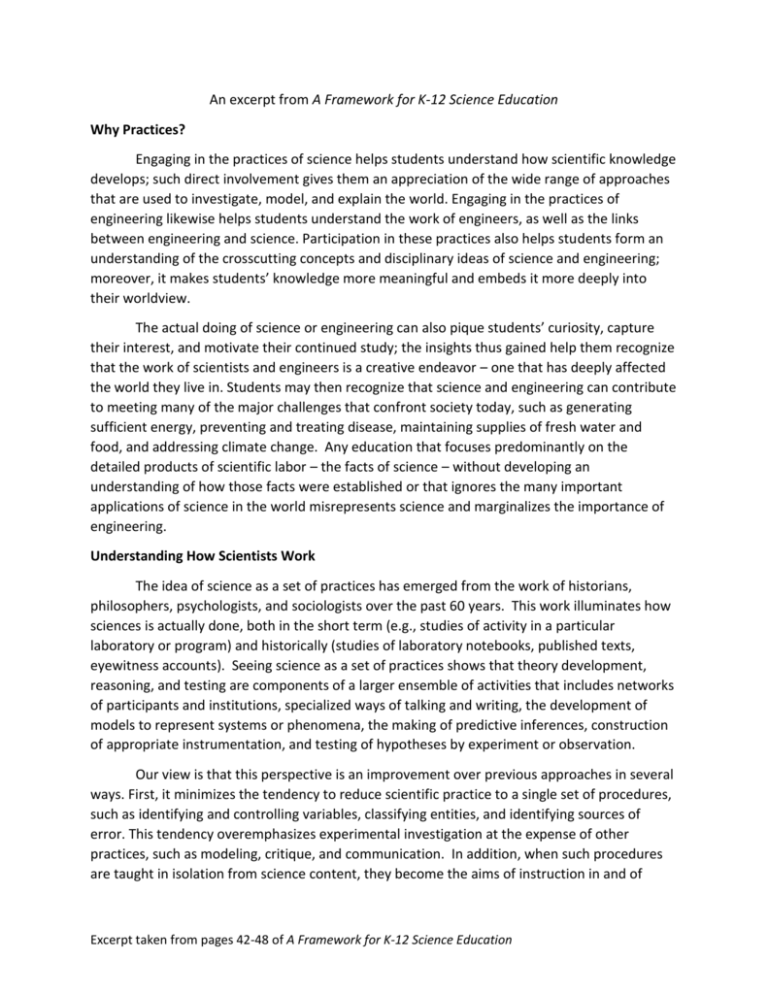
An excerpt from A Framework for K-12 Science Education Why Practices? Engaging in the practices of science helps students understand how scientific knowledge develops; such direct involvement gives them an appreciation of the wide range of approaches that are used to investigate, model, and explain the world. Engaging in the practices of engineering likewise helps students understand the work of engineers, as well as the links between engineering and science. Participation in these practices also helps students form an understanding of the crosscutting concepts and disciplinary ideas of science and engineering; moreover, it makes students’ knowledge more meaningful and embeds it more deeply into their worldview. The actual doing of science or engineering can also pique students’ curiosity, capture their interest, and motivate their continued study; the insights thus gained help them recognize that the work of scientists and engineers is a creative endeavor – one that has deeply affected the world they live in. Students may then recognize that science and engineering can contribute to meeting many of the major challenges that confront society today, such as generating sufficient energy, preventing and treating disease, maintaining supplies of fresh water and food, and addressing climate change. Any education that focuses predominantly on the detailed products of scientific labor – the facts of science – without developing an understanding of how those facts were established or that ignores the many important applications of science in the world misrepresents science and marginalizes the importance of engineering. Understanding How Scientists Work The idea of science as a set of practices has emerged from the work of historians, philosophers, psychologists, and sociologists over the past 60 years. This work illuminates how sciences is actually done, both in the short term (e.g., studies of activity in a particular laboratory or program) and historically (studies of laboratory notebooks, published texts, eyewitness accounts). Seeing science as a set of practices shows that theory development, reasoning, and testing are components of a larger ensemble of activities that includes networks of participants and institutions, specialized ways of talking and writing, the development of models to represent systems or phenomena, the making of predictive inferences, construction of appropriate instrumentation, and testing of hypotheses by experiment or observation. Our view is that this perspective is an improvement over previous approaches in several ways. First, it minimizes the tendency to reduce scientific practice to a single set of procedures, such as identifying and controlling variables, classifying entities, and identifying sources of error. This tendency overemphasizes experimental investigation at the expense of other practices, such as modeling, critique, and communication. In addition, when such procedures are taught in isolation from science content, they become the aims of instruction in and of Excerpt taken from pages 42-48 of A Framework for K-12 Science Education themselves rather than a means of developing a deeper understanding of the concepts and purposes of science. Second, a focus on practices (in the plural) avoids the mistaken impression that there is one distinctive approach common to all science – a single “scientific method” – or that uncertainty is a universal attribute of science. In reality, practicing scientists employ a broad spectrum of methods, and although science involves many areas of uncertainty as knowledge is developed, there are now many aspects of scientific knowledge that are so well established as to be unquestioned foundations of the culture and its technologies. It is only through engagement in the practices that students can recognize how such knowledge comes about and why some parts of scientific theory are more firmly established than others. Third, attempts to develop the idea that science should be taught through a process of inquiry have been hampered by the lack of a commonly accepted definition of its constituent elements. Such ambiguity results in widely divergent pedagogic objectives – an outcome that is counterproductive to the goal of common standards. The focus here is on important practices, such as modeling, developing explanations, and engaging in critique and evaluation (argumentation), that have too often been underemphasized in the context of science education. In particular, we stress that critique is an essential element both for building new knowledge in general and for the learning of science in particular. Traditionally, K-12 science education has paid little attention to the role of critique in science. However, as all ideas in science are evaluated against alternative explanations and compared with evidence, acceptance of an explanation is ultimately as assessment of what data are reliable and relevant and a decision about which explanation is the most satisfactory. Thus knowing why the wrong answer is wrong can help secure a deeper and stronger understanding of why the right answer is right. Engaging in argumentation from evidence about an explanation supports students’ understanding of the reasons and empirical evidence for that explanation, demonstrating that science is a body of knowledge rooted in evidence. How Engineering and Science Differ Engineering and science are similar in that both involve creative processes, and neither uses just one method. And just as scientific investigation has been defined in different ways, engineering design has been described in various ways. However, there is widespread agreement on the broad outlines of the engineering design process. Like scientific investigations, engineering design is both iterative and systematic. It is iterative in that each new version of the design is tested and then modified, based on what has been learned up to that point. It is systematic in that a number of characteristic steps must be undertaken. One step is identifying the problem and defining specifications and constraints. Another step is generating ideas for how to solve the problem; engineers often use research and group sessions to come up with a range of solutions and design alternatives for further development. Yet another step is the testing of potential solutions through the building and Excerpt taken from pages 42-48 of A Framework for K-12 Science Education testing of physical or mathematical models and prototypes, all of which provide valuable data that cannot be obtained in any other way. With data in hand, the engineer can analyze how well the various solutions meet the given specifications and constraints and then evaluate what is needed to improve the leading design or devise a better one. In contrast, scientific studies may or may not be driven by any immediate practical application. On one hand, certain kinds of scientific research, such as that which led to Pasteur’s fundamental contributions to the germ theory of disease, were undertaken for practical purposes and resulted in important new technologies, including vaccination for anthrax and rabies and the pasteurization of milk to prevent spoilage. On the other hand, many scientific studies, such as the search for the planets orbiting distant starts are driven by curiosity and undertaken with the aim of answering a question about the world or understanding an observed pattern. For science, developing such an explanation constitutes success in and of itself, regardless of whether it has an immediate practical application; the goal of science is to develop a set of coherent and mutually consistent theoretical descriptions of the world that can provide explanations over a wide range of phenomena. For engineering, however, success is measured by the extent to which a human need or want has been addressed. Both scientists and engineers engage in argumentation, but they do so with different goals. In engineering, the goal of argumentation is to evaluate prospective designs and then produced the most effective design for meeting the specifications and constraints. This optimization process typically involves trade-offs between competing goals, with the consequence that there is never just one “correct” solution to a design challenge. Instead, there are a number of possible solutions, and choosing among them inevitably involves personal as well as technical and cost considerations. Moreover, the continual arrival of new technologies enables new solutions. In contrast, theories in science must meet a very different set of criteria, such as parsimony (a preference for simpler solutions) and explanatory coherence (essentially how well any new theory provides explanations of phenomena that fit with observations and allow predictions or inferences about the past to be made). Moreover, the aim of science is to find a single coherent and comprehensive theory for a range of related phenomena. Multiple competing explanations are regarded as unsatisfactory and, if possible, the contradictions they contain must be resolved through more data, which enable either the selection of the best available explanation or the development of a new and more comprehensive theory for the phenomena in question. Although we do not expect K-12 students to be able to develop new scientific theories, we do expect that they can develop theory-based models and argue using them, in conjunction with evidence from observations, to develop explanations. Indeed, developing evidence-based models, arguments, and explanations is key to both developing and demonstrating understanding of an accepted scientific viewpoint. Excerpt taken from pages 42-48 of A Framework for K-12 Science Education
